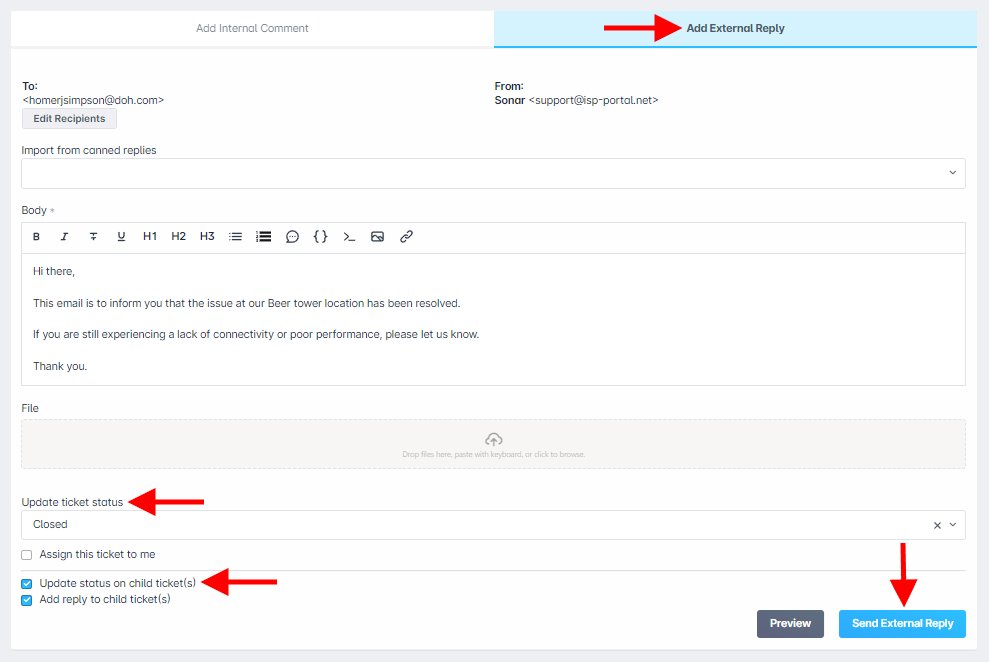Our Products & Services
Getting Started
First Time Setup
Getting Started With Jobs
Getting Started with Accounts
Getting Started with Inventory
Getting Started with Ticketing
Setting Sonar up for Billing
Baseline Configuration
How To: Using Sonar's Customer Portal
User Specific Resources
Accounts
Account Groups: Overview & Example Use Cases
Account List View: Overview
Account Management View: Overview
Account Overview Customization
Account Statuses: Overview & Example Use Cases
Account Types: Overview & Example Use Cases
Anchor & Linked Serviceable Addresses: Overview and Best Practices
Archiving an Account: Overview
CPUC Fixed Broadband Deployment by Address
Child Accounts: Best Practices & How Tos
Creating a New Account
Direct Messages: Overview
Disconnecting an Account
Disconnection Reason Management: Overview
Exploring Task Groups
FCC Broadband Data Collection (BDC) Filings: How Sonar Can Help
FCC Data Exports: General Overview and Usage
Future Serviceable Addresses: Overview
Lead Intake Form Processing
Notes: Best Practices & Use Cases
Scheduled Events: Overview & Use Cases
Serviceable Addresses: Overview and Usage
Specify Account ID upon Creation
Tasks & Task Templates: Overview
Using Sonar's FCC Broadband Label Generation Tool
Billing
ACH Batching: Overview
Accounts in Vacation Mode
Avalara: Overview & Setup
Batch Payments & Deposit Slips: Overview
Billing Calculator
Billing Defaults
Billing Settings
Building Packages
Building a Data Service
Canadian ACH tool
Changing Service Pricing in Sonar: Best Practices
Considerations When Using Avalara with Voice Services
Creating Discounts for Services and Packages
Delinquency Billing Best Practices
Delinquency Exclusions: Overview and Use Cases
Dual Data Services: Overview
Email Invoice Batch: Overview
General Ledger Codes: Overview
General Transactions: Best Practices
How Sonar Prorates Billing
How to Take Bank Account Payments
How to: Adding a Service to an Account
Invoice Templates: Overview
Leveraging PayPal as a Payment Method in Sonar
Manual Transactions
Multi-Month Billing & Multi-Month Services
Print to Mail
Printed Invoice Batches: Overview
Services: Overview
Setting Up Payment Methods and Taking Payments
Setting up Bank Account & Credit Card Processors
Taxes Setup
Usage Based Billing Policies: Overview and Usage
Usage Based Billing Policy Free Periods: Overview and Usage
Using Tax Exemptions - How To
Communication
Communications: Call Logs Overview & Best Practices
Communications: Messages Overview
Email Variables & Conditions
Message Categories: Overview & Use Cases
Phone Number Types: Overview and Use Cases
Saved Messages: Overview
Setting up an Outbound Email Domain
Trigger Explanations
Triggered Messages: Setup
Using Outbound SMS
Using the Mass Message Tool
Companies
How to: Setting Up a Company in Sonar
Managing Multiple Companies in Sonar: Best Practices
Rebranding your Sonar Instance
Financial
Contract Templates
Invoice Attachment Use Cases & PDF Examples
Invoice Messages: Overview & Use Cases
Invoices in Sonar: Examples, Creation & Contents
Integrations
Atlas Digital CORE Integration
Calix Cloud Data Field Mappings
Calix SMx Integration: Overview
CrowdFiber Integration
External Marketing Providers
GPS Tracking Providers: Overview
GoCardless Integration: Overview & Setup
How to Connect Cambium to your Sonar Instance
How to Connect Preseem to your Sonar System
How to: Using Webhooks in Sonar
Integrating with Calix Cloud
RemoteWinBox - Integration with Sonar
Sonar Retain: AI-Powered Customer Retention & Quality Intelligence
The Sonar Field Tech App
Tower Coverage Integration: Overview
VETRO FiberMap V2 Integration: Overview
VETRO FiberMap V3 Integration: Overview
Webhooks in Sonar: Basic PHP Example
iCalendar Integration
Inventory
Inventory List View: Overview
Inventory Model Management: General Overview
Network Inventory: How-to & Usage Guide
Segmentable Inventory: How-to & Usage Guide
Setup of Inventory: Manufacturers, Categories, and Assignees
Tracking and Using Consumable Inventory
Jobs
Applying Task Templates to Jobs
Edit Job Options
Example Jobs & Templates
Geofences: Overview
Job Types: Best Practices
Jobs and Scheduling: Overview
Scheduling How-to: Creating and Booking a Job
Scheduling Week View: Overview
Setting Up Schedules General Overview
Mapping
Misc.
Combining Custom Fields & Task Templates for Information Storage
Custom Fields Overview & Use Cases
Custom Links: Overview
Task Templates Overview & Use Cases
Monitoring
Building Alerting Rotations
Building a Monitoring Template
Poller Troubleshooting
Pollers: General Overview, Deployment Strategy, Build Out & Setup
Networking
Adtran Mosaic Cloud Platform Integration: Overview
Assigning RADIUS Addresses
Assigning an IP Address Using Sonar's IPAM: How to
Automating IP Assignments, Data Rates, and Network Access in Sonar
Building Address Lists
Building RADIUS Groups
Building a Device Mapper
Cable Modem Provisioning
Controlling Customer Speeds with Sonar: General Overview
DHCP Delivery
Data Usage Available Methods
Finding your OIDs
FreeRADIUS 3: Build-Out & Integration
How Sonar Communicates - Egress IPs Explained
IP Assignments & Sonar
IPAM: Basic Setup
IPAM: Overview
LTE Integration
MikroTik as an Inline Device: Integration With Sonar
MikroTik: Controlling Access
MikroTik: Controlling Speeds
MikroTik: Setting Up a Sonar Controlled DHCP Server
Netflow On-Premise Integration: Setup and Overview
Network Dashboard: Overview
Network Sites: Management View Overview
PacketLogic: Integration With Sonar
Pulse, Polling, and PHP
RADIUS: Build-Out & Integration with Sonar
RADIUS: Building Reply Attributes
Setting Up CoA Proxy
Sonar Flow
Sonar IP Addressing
Using Multiple Network Devices in Sonar
Purchase Orders
Release Notes
Reporting
Enhanced Business Intelligence - Tips & Tricks for Advanced Users
How To Enhance Your Reporting With Custom Field Data
Report Licenses
Sonar's Business Intelligence: Overview
Understanding Sonar Reports
Using Sonar DataConnect to Connect BI Applications with Your Sonar Instance
Security
Application Firewall: General Overview and Best Practices
Auth0: Overview
Multi-Factor Authentication: Overview
Password Policy In Depth
Removing a Terminated Employee In Sonar
Role Creation using GraphiQL
User Role Creation & Best Practices
Users: Overview
Sonar Billing
sonarPay
sonarPay Canada Disbursements: Overview
sonarPay Chargebacks & Disputes: Overview
sonarPay Disbursements: Overview
sonarPay Monthly Statement: Overview
sonarPay Overview
sonarPay Reversals, Voids, & Refunds: Overview
sonarPay: Token Migration Process
System
A Deeper Dive into the New Sonar API
API Calls Using Third Party Applications: Personal Access Tokens
Browser Compatibility and Minimum Hardware Requirements for Sonar
Consuming the Sonar API
Controlling Your Landing Page: Personal Preferences
Customizing Your Customer Portal
Date/Time Picker: Overview
Dynamic Time Zones in Sonar
Filtering: Overview
Frequently Used Terms
Getting Your Data into Sonar
GraphQL Rate Limiting Overview
How To Use GraphiQL to Understand the Sonar API
How Your Data is Backed Up
How to Best Use Global Search
Interacting with Files via the API
Introducing the New Sidebar
Main Menu: Overview
Mutations in the Sonar API
Notification Preferences
REST API Wrappers for V1 Compatibility
SMS Notifications
Sonar's Rich Text Editor
System Settings: Overview
The New Sonar API
Troubleshooting the Customer Portal
Upgrading your Ubuntu OS - Customer Portal Upgrades
User Profile: Your Personal User Settings
Ticketing
Advanced Ticketing Features
Canned Replies Examples & Templates
Canned Reply Categories
Exploring Ticket Groups
How Sonar Manages Spam Tickets
How to Integrate Inbound Mailboxes with Slack
Inbound Mailboxes Example Build
Ticket Category Families & Ticket Categories: Overview
Ticket Resolution Reasons: Overview
Ticketing: Overview
Using Parent Tickets
Voice
API Changes for Voice Billing
Best Practices to Remain CPNI Compliant
Billing Voice Services in Sonar
Deploying Voice Services in Sonar
Working With the Sonar Team & Additional Resources
Sonar's Security Practices & Certifications
Sonar and General Data Protection Regulation (GDPR)
Sonar's Security Strategies
Technical Security Overview
Best Practices for Fast Tracking a Support Request
Feedback Portal / Suggest a Feature
Learning with Sonar: Tools and Resources
New Client Training Overview
Sonar Casts Table of Contents
Submitting Bugs vs. Feature Requests
The Sonar Community Forum
The Sonar Status Page
Third Party Customer Support Referrals
Table of Contents
- All Categories
- Ticketing
- Using Parent Tickets
Using Parent Tickets
 Updated
by Jennifer Trower
Updated
by Jennifer Trower
Read Time: 5 mins
Within Sonar's ticketing interface it is possible to assign a parent ticket to link tickets together in a parent/child relationship. A parent ticket can have multiple child tickets attached to it and provides you with the ability to easily track related tickets, mass update the ticket statuses, and also have any comments and/or public replies automatically populate to all child tickets. This is particularly helpful in situations where you have a primary issue that is the root cause for multiple accounts, such as a network outage or a bug that multiple customers are reporting.
For example, as customers send in tickets you might notice that many of these tickets are referring to the same issue - such as multiple customers experiencing issues accessing the customer portal, or customers experiencing issues due to a tower outage. You could handle the tickets on a one by one basis, which would involve manually updating the status of each ticket as well as posting any necessary comments and/or replies to each individual ticket. However, using the parent ticket functionality will allow you to do this, but in a quicker and more efficient way. You can designate one ticket as the parent and add the rest of the related tickets as children. This way you can easily inform all reporting customers of any updates regarding the issue, and once it is resolved, can quickly send out a reply to all tickets at once and update all of the ticket statuses to closed.
How To Add A Parent Ticket
To add a parent ticket, first, navigate to the ticket that you want to make the child. Once you have found your desired child ticket from within your ticketing interface, open up the Edit Ticket menu. To get the Edit Ticket menu opened, follow the steps below:
- Click on applicable ticket title to open up the ticket.
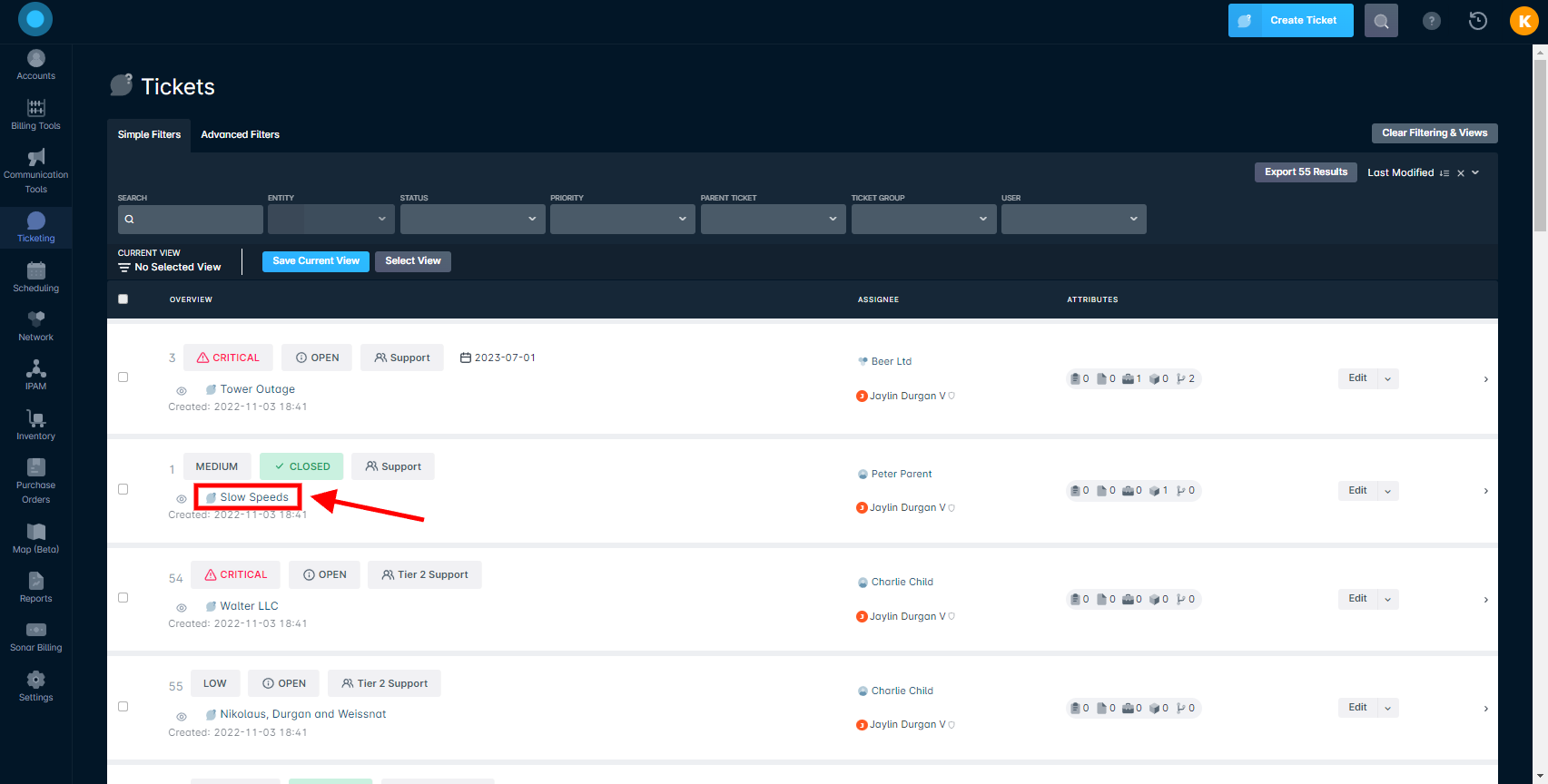
- With the ticket populated, click on "Edit".
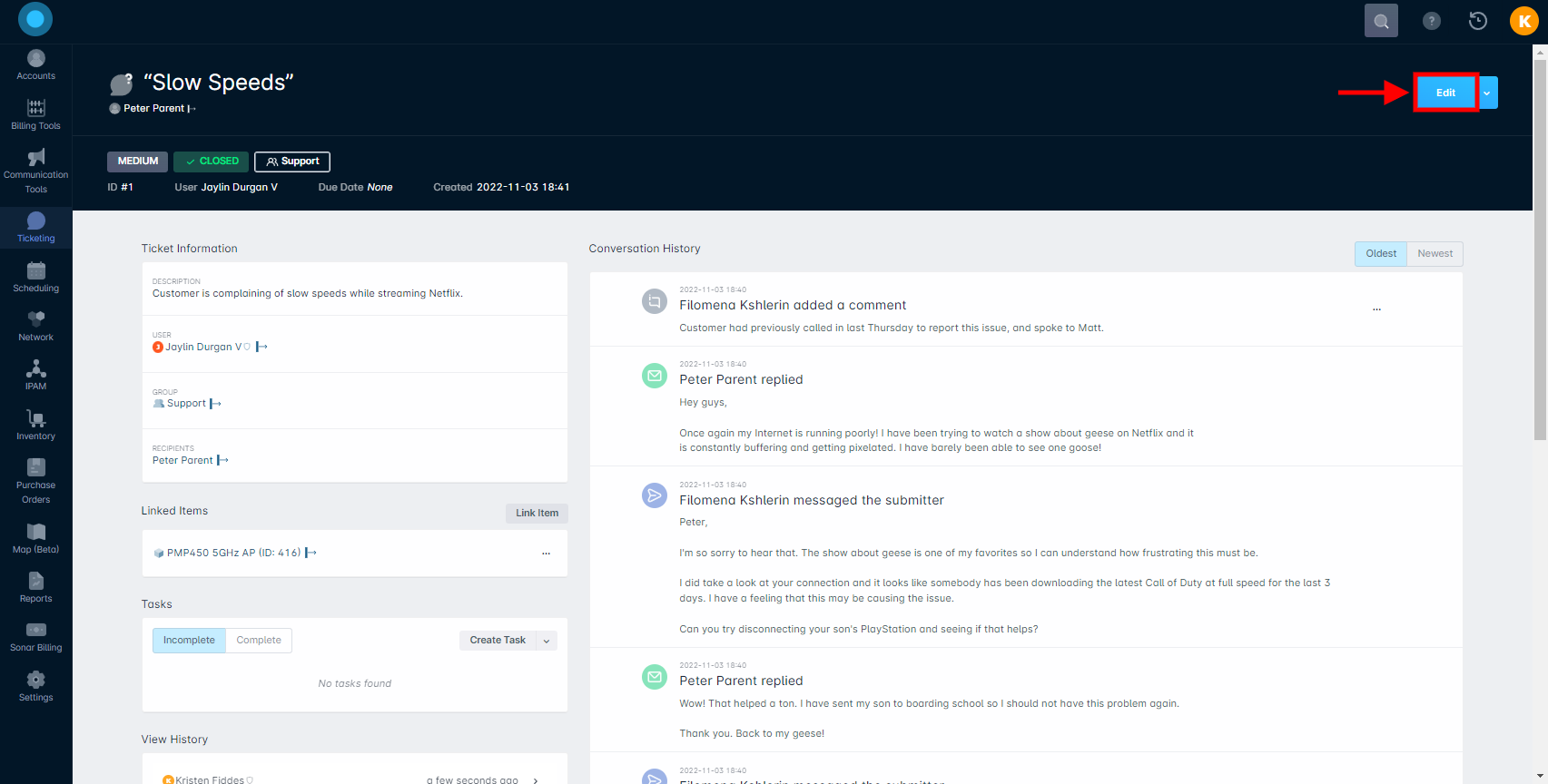
- From the Edit Ticket modal, select which ticket you would like to assign as the parent from the "Parent Ticket" dropdown menu.
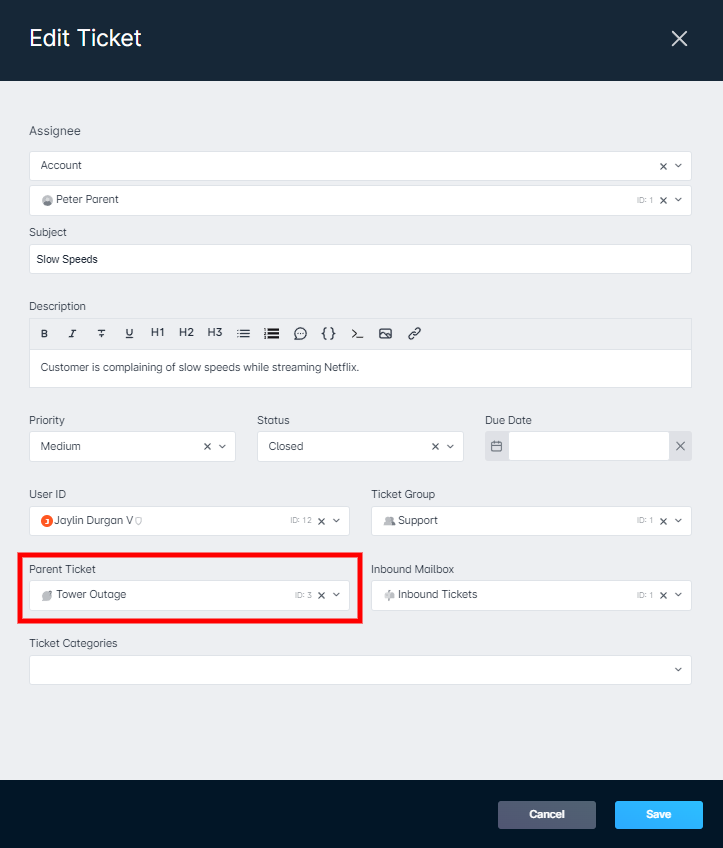
Once you have linked the tickets, you will be able to see the parent ticket listed now when you navigate to the details of the child ticket, both within the sidebar menu and also on the ticket screen (ticket screen is pictured below).
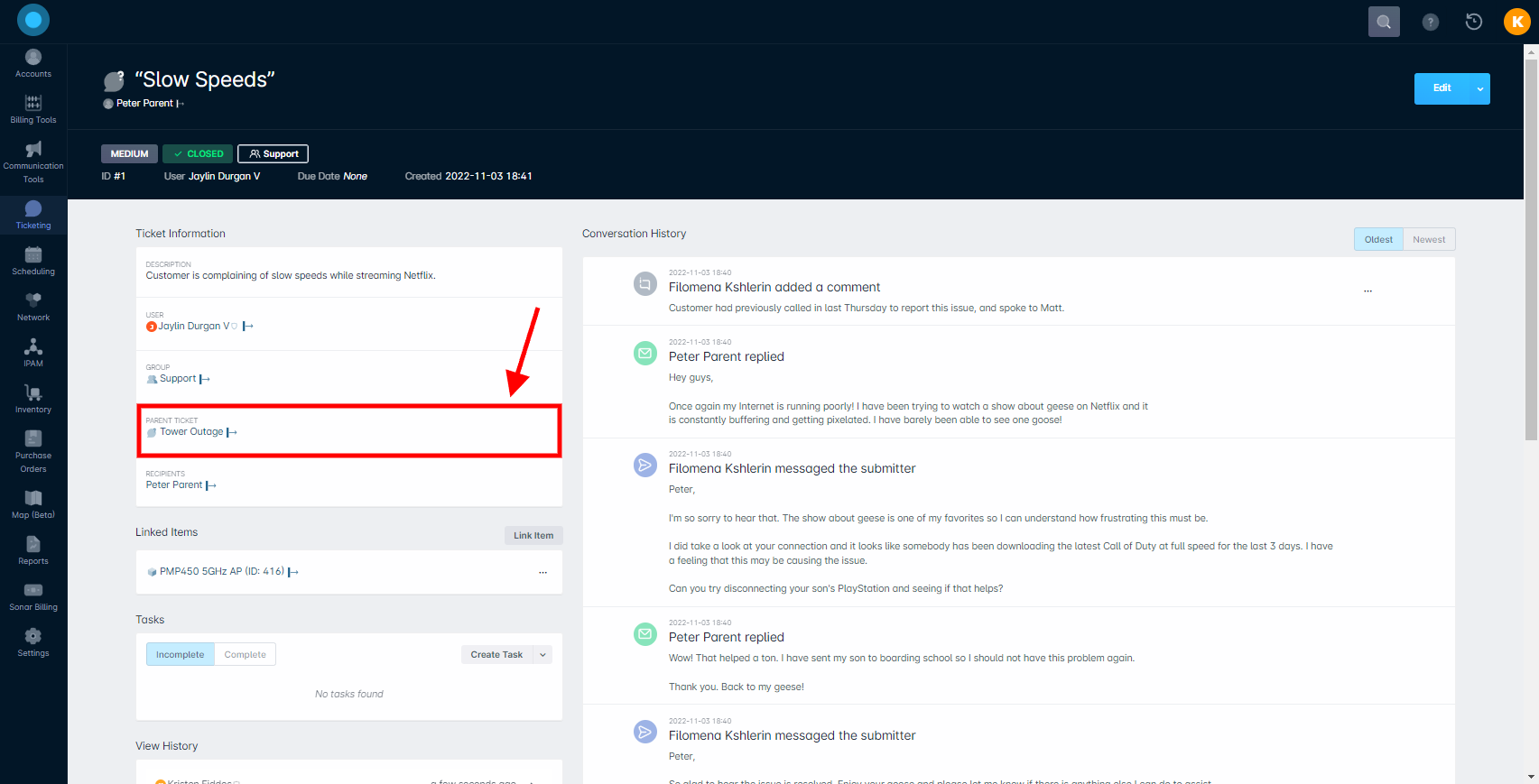
After the child/parent relationship has been established between tickets, you will also be able to see the child tickets listed from within a parent ticket.
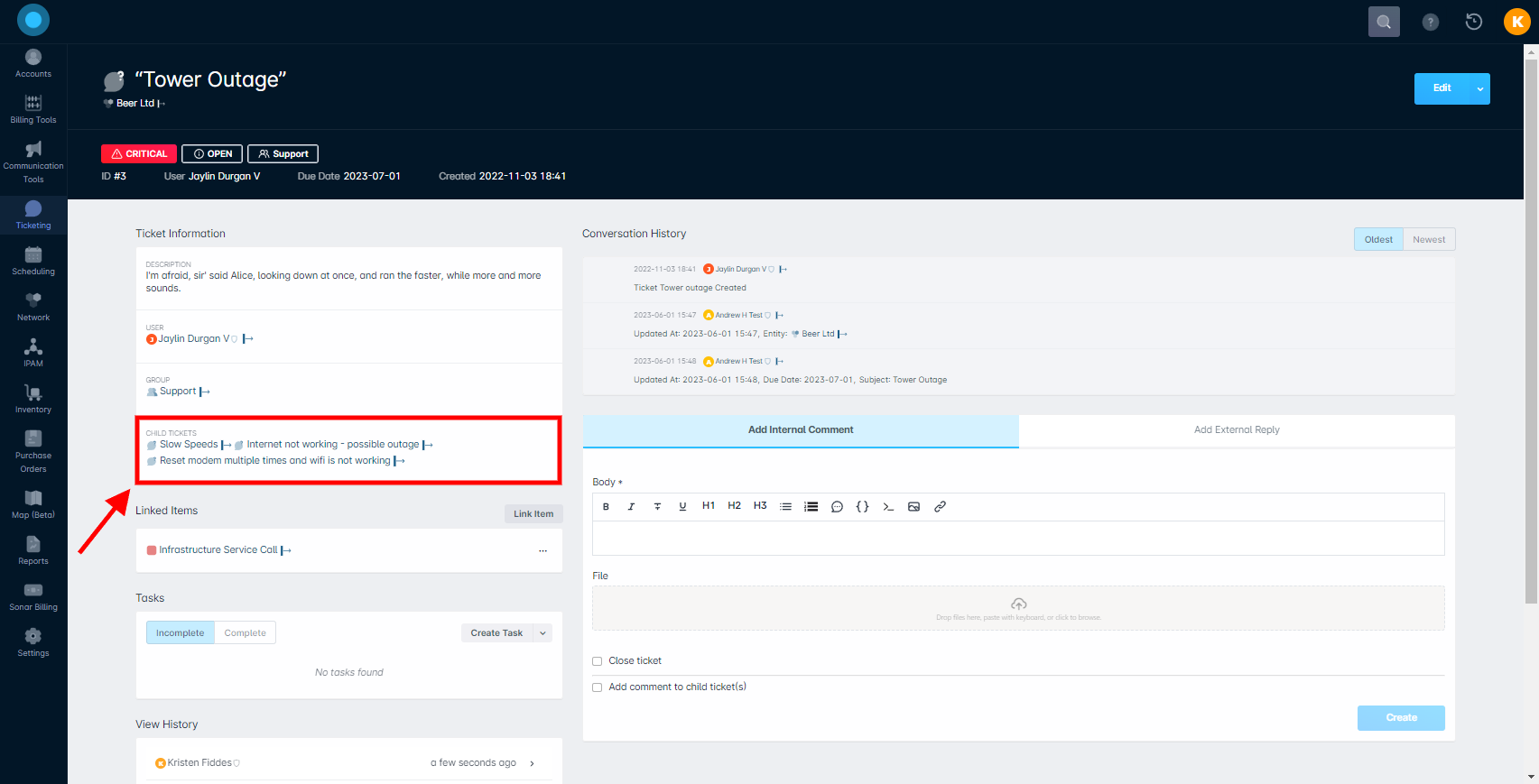
Comments, Replies & Status Changes
With parent tickets you can push any comments and/or replies out to all child tickets under that parent, and also mass change the statuses of all the tickets at once.
How To Post Comments
To post a comment to all child tickets, navigate to the screen of the parent ticket that the children are attached to. The "Add Internal Comment" tab is open by default – under that tab, enter in the text you wish to add to all related tickets. Ensure the "Add comment to child ticket(s)" box is checked, and click "Create". This will add an internal comment to the parent ticket and all child tickets that are attached to it.
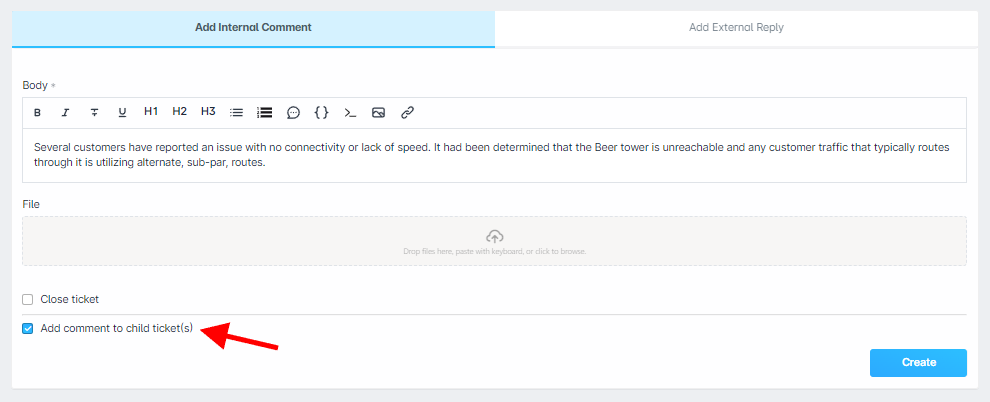
The comment will now be visible under the Conversation History header on the parent ticket and all associated child tickets.

How To Send Replies
To send replies out to all recipients listed on the parent ticket as well as all child tickets, first navigate to the screen of the parent ticket. Click into the "Add External Reply" tab and fill out the text you wish to send within the Body section of the email. Next, make sure the "Add reply to child ticket(s)" box is checked and then click "Send External Reply".
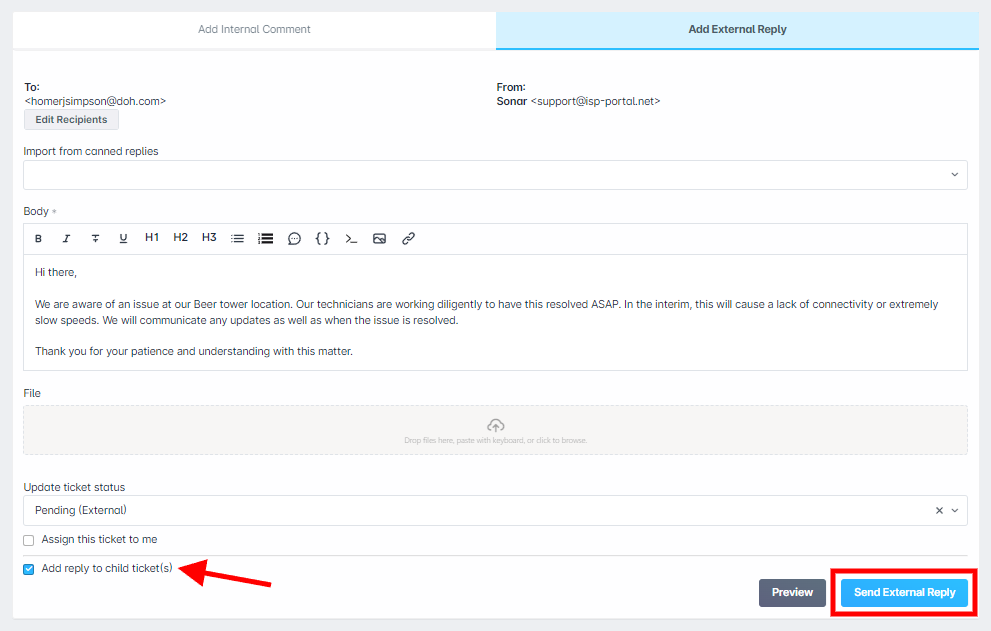
The reply will be sent out to all child tickets that are under the parent, and will now be visible from within each ticket's conversation history.
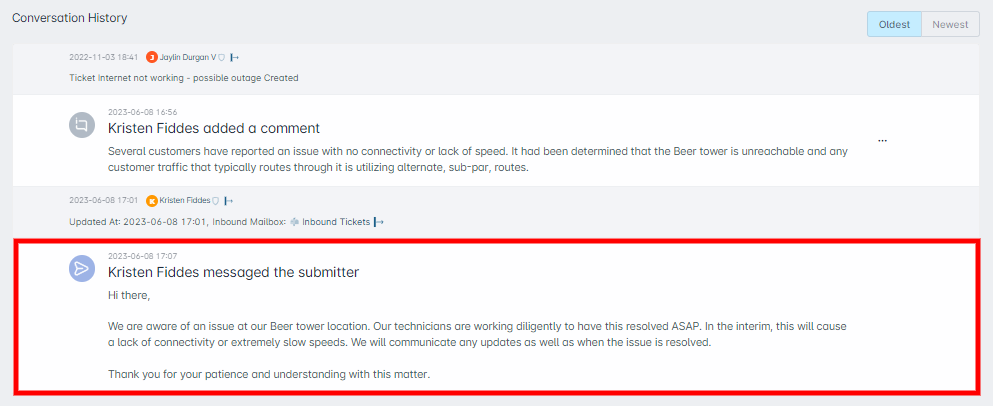
How To Change Statuses
To change the status of the parent ticket and all associated child tickets, first, navigate to the screen of the parent ticket. You can update the status of all tickets to Closed through the use of comments, or you can update the tickets to any available statuses through the use of sending replies.
Using A Comment To Update Status: Ensure you are in the "Add Internal Comment" tab and fill out the text you wish to post as a comment. Make sure the "Close ticket" and "Update status on child ticket(s)" boxes are both checked – you can only update the status of tickets to Closed through the use of posting a comment. If you only have the "Close ticket" box checked, it will only change the status of the parent ticket – not the children tickets. If you want the comment to be posted to all children tickets, also select the "Add comment to child ticket(s)" box. When ready to close out the tickets and post the comment(s), click "Create".
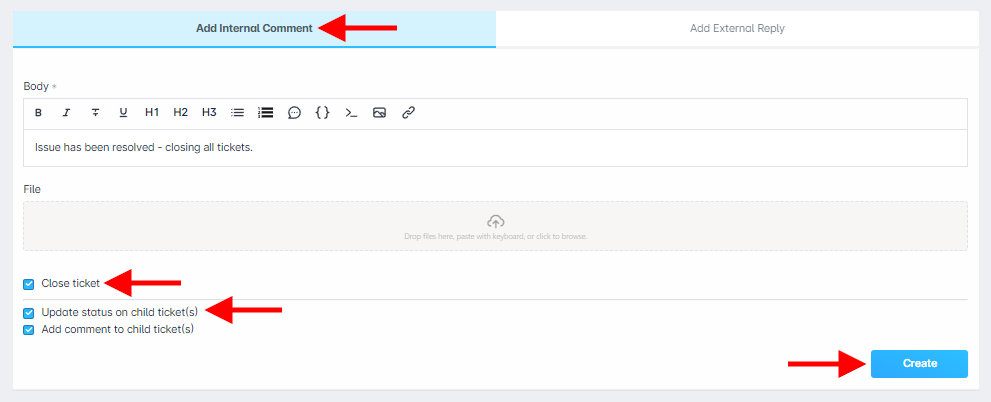
Using A Reply To Update Status: Ensure you are in the "Add External Reply" tab, and fill out the Body section of the email. Then, choose the status you want to update all the tickets to from the dropdown menu "Update ticket status". Add a checkmark alongside the "Update status on child ticket(s)" box – if it is not checked, only the status of the parent ticket will be updated. If you want the reply to be sent out to all child tickets, ensure the "Add reply to child ticket(s)" box is checked as well. When ready to send out your reply and update the ticket status, click "Send External Reply".
